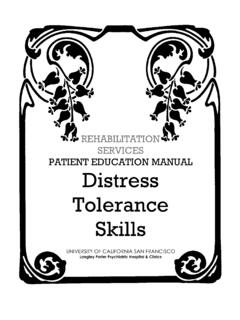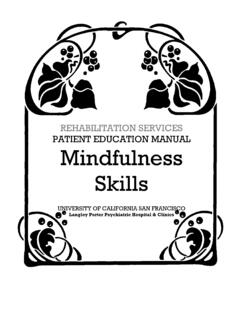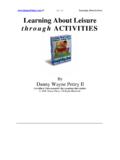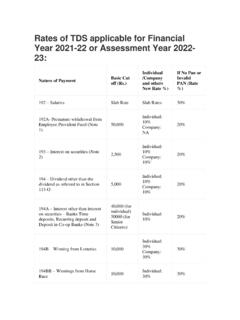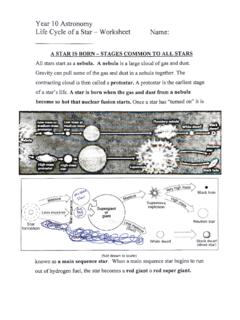Transcription of REHABILITATION SERVICES PATIENT EDUCATION MANUAL …
1 REHABILITATION SERVICES PATIENT EDUCATION MANUAL Emotion Regulation Skills UNIVERSITY OF CALIFORNIA SAN FRANCISCO Langley Porter Psychiatric Hospital & Clinics 2 THE GOALS OF EMOTION REGULATION 1. UNDERSTANDING YOUR EMOTIONS The first step in regulating emotions is learning to identify and label your emotions. Learning the purpose your emotions serve or the needs they fulfill is helpful so that you can identify what gets in the way of reducing painful emotions. 2. REDUCING EMOTIONAL VULNERABILITY The goal is to reduce emotional vulnerability by learning to decrease negative emotions and to increase positive emotions.
2 3. DECREASING EMOTIONAL SUFFERING We can learn to let go of painful emotions by being mindful of them, instead of fighting them or walling them off. We can also learn to change negative or painful emotions by acting in a manner opposite to them. 3 EMOTION REGULATION SKILLS These skills can help you control your emotions when under stress. The focus of these skills is to learn how to cope with emotional pain and to help increase positive emotional experiences in your everyday life. Strategies include: 1.
3 Learning to identify and label your emotions. 2. Learning to understand the functions these emotions serve. 3. Learning to reduce painful, negative emotions and to let go of emotional suffering. 4. Learning to increase positive emotions. 4 PREVENTION (Or How to stay out of Emotion Mind ) 1. Take care of your body. See a doctor when necessary. Take prescribed medications. 2. Don t eat too much or too little. Stay away from foods that make you feel overly emotional (such as foods with lots of sugar or caffeine).
4 3. Stay off non-prescribed drugs, including alcohol. 4. Try to get the amount of sleep that helps you feel good. Keep to a sleep program if you are having trouble sleeping. 5. Do some sort of exercise every day; try to build up to 20 minutes of aerobic exercise. 6. Try to do one thing each day to make yourself feel competent and in control. 5 WHY LEARN TO OBSERVE AND DESCRIBE EMOTIONS? In order to control your emotions, you must be able to separate or step back from them so you can think of using coping strategies.
5 At the same time, remember to accept them as part of yourself and not something outside of you. Studies have shown that people who can identify their emotions move through depression faster. By learning to observe and describe your emotions, you learn both to be separate from them and also to accept them so they don t distress you so much. 6 TAKING STEPS TO GET BACK IN CONTROL OF YOUR EMOTIONS 1. Start by taking a time-out. 2. Stop what you re you feel warning signs of strong anger or distressing feelings and you start to thinking angry or disturbing thoug,hts, tell yourself to stop.
6 This may help you calm down and think more clearly. 3. TRY TO RELAX Count to 10 or 100 Get a drink of water Take a walk Take several slow deep breaths 4. Return when you re you ve got your overwhelming emotions under control, go back and talk to the person or face the situation that triggered your emotional distress. 7 THE SPECIAL CASE OF ANGRY FEELINGS EXAMPLES When you were too busy to talk to me, I felt < (ABANDONED) > angry . When you don t let me help you, I feel < (OUT OF CONTROL) > frustrated . When you criticize me, I feel < (INADEQUATE) > enraged.
7 When you yell at me, I feel < (ABUSED) > revengeful . When you don t make time for me, I feel < (UNIMPORTANT) > resentful . When you don t stick to our agreements, I feel < (POWERLESS) > infuriated ANGRY FEELINGS are valid and important, but are most beneficial when used as indicators that someone or something is triggering an uncomfortable feeling in you. To accurately figure out what you are reacting to, it s necessary to backtrack and identify the feeling that came FIRST before the angry reaction replaced it. Angry feelings almost always follow and replace a different initial emotion that is too uncomfortable to let ourselves acknowledge.
8 We quickly skip over this uncomfortable feeling so fast that we re usually not even aware of it and replace it with an angry type of feeling. The anger is really a reaction to that initial emotion, whether we re consciously aware of it or not. 8 IDENTIFYING WHERE YOU EXPERIENCE EMOTIONS IN YOUR BODY Draw where in your body you feel: LOVE JOY SADNESS SHAME FEAR GUILT ANGER Which emotion is easiest to identify? Which is hardest? 9 EMOTION DIARY (How to observe and describe your emotions) Choose two current or recent emotional reactions you had and fill out as much of the worksheet below as you can.
9 _____ Record your strongest emotion of the day, or the longest-lasting one, or the one that was most painful or gave you the most trouble. Analyze that emotion. Fill out the MINDFULNESS OF MY EMOTIONS worksheet on the next page as well. Day Event Emotion Function (What happened?) (What are you trying to communicate, how does it serve you, what do you need?) _____ _____ _____ _____ _____ _____ _____ Emotion: _____ 10 MINDFULNESS OF MY EMOTIONS EMOTION NAME(S):_____ INTENSITY (0-100):___ Prompting event or trigger for my emotion (who, what , when where just the facts): Thoughts/interpretations (beliefs, assumptions): about the Body sensations (where in my body do I feel this emotion?)
10 What was by body language facial expression, postures?): Action (What did I do? What did I say?): How did the emotion affect me afterwards? (Were there secondary emotions? What did I do after the event or trigger?): 11 THREE WAYS TO LET GO OF EMOTIONAL SUFFERING 2. Experience your Emotion Experience it as a wave, coming and going. Try not to block emotion. Open yourself to the flow of the emotion. Try not to suppress emotion. Don t push the emotion away. Don t try to get rid of emotion. At the same time, don t try to keep emotion around.
